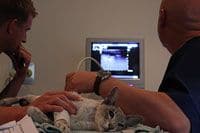Chocolate Toxicity (why can’t pets eat chocolate?)
Chocolate is loved by many and is a cornerstone to countless celebrations through birthday cakes, cookies and most notably Easter. Yet these celebrations are dangerous times for pets, especially dogs, as they can be poisoned by consuming even the smallest piece of the sweet treat. Chocolate is the most common cause of poisoning in dogs, resulting in serious health concerns and in some cases has been fatal. It is essential to understand the signs and symptoms of chocolate poisoning and what you should do if poisoning occurs.
Why is chocolate poisonous to pets?
The main ingredient in chocolate is cocoa. Cocoa beans contain two methylxanthines, theobromine and caffeine, which are naturally occurring stimulants found in various foods. However, theobromine and caffeine are toxic to a number of animals including dogs, cats and other pets.
Theobromine is poisonous to pets as they are not able to metabolise it as quickly as humans, causing it to build up to a level that is toxic to their system. This build-up of toxins is called chocolate toxicity.
Caffeine, while also harmful to pets is present in much smaller concentrations and less likely to severely affect them when consumed.
Are all types of chocolate poisonous?
While it is always best to avoid giving your pets chocolate, some types are more toxic than others. The concentration of theobromine in the chocolate determines its toxicity. An easy way to tell how poisonous the chocolate is through its darkness – the darker the chocolate, the higher level of theobromine it contains, meaning the more toxic it is.
In descending order of toxicity (most to least toxic) is:
- Cocoa powder
- Baking/cooking chocolate
- Dark chocolate
- Milk chocolate
- White chocolate
It is important to remember that even white chocolate eaten in a large enough amount can cause serious health issues to pets. It is always best to avoid giving any food containing chocolate to your pets.
Can I feed my pets small amounts of chocolate?
In short, no. Although some people will declare their pets have eaten chocolate without any ill effects it is best not to take the risk. Like any potential toxin, a pet’s reaction to chocolate is dependent on several factors such as the type and amount of chocolate ingested as well as the weight of your pet. Darker chocolates, as mentioned above, are the most toxic and as little as five grams can cause potentially severe reactions or even death in a small dog. Even bake items made with cocoa powder and other chocolate products can be hazardous to pets. Although white chocolate contains very little or no theobromine (or caffeine); cocoa butter, sugar, butter and milk solids can still be hazardous and cause symptoms like an upset stomach or pancreatitis.
In general, larger animals will be able to consume more chocolate than their smaller counterparts. Bigger and heavier pets may also have delayed onset of poisoning symptoms due to their size. However, this does not mean they are less likely to be affected by chocolate toxicity, it just takes longer to present and may have fewer severe symptoms.
if you suspect your pet has eaten chocolate, no matter how little the amount, consult with your vet immediately.
The symptoms of chocolate toxicity
If your pet has potentially ingested a toxic amount of chocolate, you will need to keep an eye on them for the next 24 hours and contact a vet immediately should they show any of the below signs or symptoms of poisoning.
Early signs are mild and include:
- Gastrointestinal upset
- Vomiting
- Diarrhoea
- Excessive urination
- Increased thirst
These can progress to including:
- Hyperactivity
- Increased heart rate
- Hyperthermia
- Pancreatitis
Finally leading to the severe symptoms of:
- Depression
- Heart arrhythmias and heart failure
- Tremors
- Seizures
- Coma
Treatment should be sought immediately once symptoms present as poisoning can progress quickly. Although rarely fatal, chocolate toxicity can make pets severely ill. Young, senior and pets with pre-existing conditions, particularly heart conditions, are more at risk for poisoning than others.
What to do if your pet eats chocolate
If you catch your pets eating chocolate, immediately remove it from their reach and remove as much as possible from their mouth. However, it is more common to find empty wrappers or packaging after the fact than to catch them in the act.
If you believe, or even suspect your pet has ingested chocolate, never try to induce vomiting yourself. Instead, determine what kind and how much chocolate was eaten while keeping an eye on your pet for signs of poisoning. The next step is to call your vet who will use the information you gathered to advise you if a toxic amount has been ingested and if you need to attend a clinic.
Chocolate toxicity calculator
If your canine friend has helped themselves to some chocolate and you know the type of chocolate they’ve eaten and how much, the below chocolate toxicity calculator will be able to tell you if they have eaten a toxic amount.
Simply by inputting your dog’s weight, type of chocolate, and the amount they have eaten, the calculator will be to say approximately how much theobromine and caffeine they have actually ingested and what symptoms they may experience.
Please note this calculator should not be used as a substitute for veterinary advice, it is only intended as a guide. If your dog has eaten chocolate, contact your local vet or our team as soon as possible.
How do vets treat chocolate toxicity?
To best treat poisoning, your vet will calculate the toxicity level ingested based on your pet’s weight, the type of chocolate (if possible, bring the wrapper with you) and how much was consumed. As there is no antidote to theobromine, treatment involves supportive care only. This includes:
- Inducing vomiting to remove the remaining toxin from the stomach
- IV fluids to assist in flushing the remaining toxins as well as for hydration
- Administering activated charcoal to stop the toxin from being further absorbed into the body
- Regulate heart rate through medication
- Control seizures through medication
- Use of a urinary catheter to prevent secondary reabsorption through the bladder
What about chocolate treats designed for pets?
So that your furry friend does not miss out, many treats have been designed to look like they contain chocolate, but an animal-friendly substitue called carob is in fact used. They are often confused due to their similar appearance and carob is naturally sweet like chocolate. However, carob does not contain theobromine or caffeine, so is safe for your pet to consume. It also has additional health benefits and is a great source of fibre for dogs. There are also a wide variety of pet-friendly recipes online which use carob for those interested in handmade sweet treats for your pet instead of purchasing ready-made treats.
If your pet has eaten chocolate or you suspect they have, contact your local vet immediately or our Perth Vet Emergency hospital.



